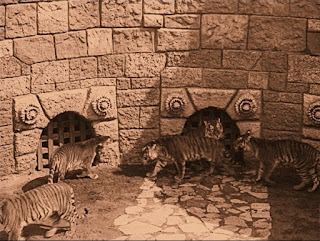Joe May’s 1921 silent epic The Indian Tomb was based on Thea von Harbou's very successful 1918 novel The Indian Tomb. Thea von Harbou was of course married to Fritz Lang. Lang and von Harbou wrote the screenplay for the film.
The novel, although extremely good, contains one very serious flaw. Interestingly enough that flaw is corrected in the movie. I don’t know whether it was von Harbou or Lang or May who made the change but it was very much a change for the better.
The movie is in two parts, Part I: The Mission of the Yogi (Die Sendung des Yoghi) and Part II: The Tiger of Bengal (Der Tiger von Eschnapur). It is in fact a single story with no obvious break between the two parts and the only reason it was originally released that way was the 3 hours and 40 minutes running time.
The story begins with a prologue. A yogi buried alive is resuscitated by the fabulously rich Ayan III, the Prince of Bengal (Conrad Veidt). According to legend when this happens the yogi must grant the person who revives him one wish. The prologue is important because it establishes that the yogi, Ramigani (Bernhard Goetzke), has supernatural or at least paranormal powers. And it establishes that Ramigani is compelled to carry out out the Prince’s commands even when he disagrees with them.
The Prince instructs Ramigami to persuade famed architect Herbert Rowland (Olaf Fønss) to travel to India to build a tomb for him. Herbert understands that the tomb will house the body of a princess, the beloved of the Prince. Herbert is persuaded that he must leave for India immediately without informing his fiancée Irene Amundsen (Mia May). Herbert departs on the Prince’s steam yacht. Irene is however a resourceful woman and she sets off for India as well.
On arrival in India Herbert discovers that there are very important things he hadn’t been told. The tomb is not to house the body of the Princess. It is to house the memory of a Great Love. A love betrayed. The Princess is alive. She has betrayed the Prince with a dashing but unscrupulous British officer and hunter, MacAllan.
The Prince has plans for revenge but his plans are not straightforward.
Herbert suffers several misfortunes, the most serious being that he is infected with leprosy. Nothing can save him. Or perhaps something can. But the price will be terrible.
MacAllan is a hunted man.
Irene is more or less a prisoner. The Prince’s feelings towards her are ambiguous. It’s possible that he desires her but his feelings about women are more than a little distorted.
Herbert and Irene become involved in attempts to rescue the Princess.
There is plenty of action and adventure. Narrow brushes with hungry tigers! Crocodile-infested rivers. A desperate escape across a rickety rope bridge over a chasm. A shootout at MacAllan’s bungalow. All filmed with style and energy.
This is however mostly a story about love. It’s a story of love betrayed, of misguided misplaced love, obsessive love, unhealthy love. But also noble love and faithful love.
Conrad Veidt is perfectly cast. He could play heroes or villains or victims or mysterious ambiguous characters and the Prince is all those things. He is probably mad, but he was probably once a very good man. Veidt also had tremendous magnetism. He’s in top form here.
The whole cast is good.
There’s plenty of interesting ambiguity. The Prince is not a mere villain. He is a man so shattered by emotional betrayal that he is no longer quite sane. The Princess is no innocent victim. She did betray the Prince’s love. And MacAllan is no hero. He not only seduced the Princess but boasted about it afterwards. Hebert Rowland is perhaps a little ambiguous as well, a man who allowed his artistic ambition to override his judgment. The yogi seems sinister at first but then we start to wonder.
This is a breathtakingly lavish production. The sets are jaw-dropping.
The movie might be better remembered had Lang directed it himself but I can’t fault May’s direction. This is a stunning emotionally complex movie and it’s very highly recommended.
I’ve reviewed Thea von Harbou's novel The Indian Tomb and also Lang’s own 1959 version, Fritz Lang's The Tiger of Bengal and The Indian Tomb (1959).
I’ve also reviewed another worthwhile Joe May movie, Asphalt (1929).





No comments:
Post a Comment